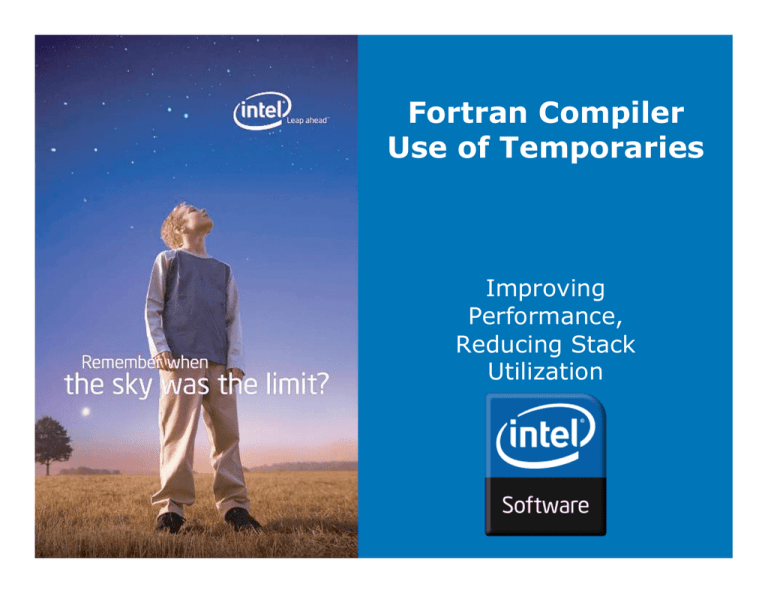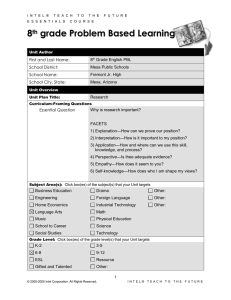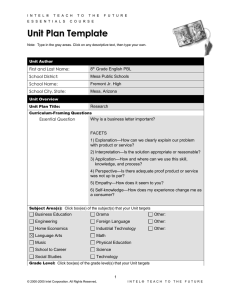
Fortran Compiler
Use of Temporaries
Improving
Performance,
Reducing Stack
Utilization
Software
&Solutions
group
Problems and Concerns: Agenda
• Stack Application runs out of stack and aborts
• Application creating temporary copies of actual arguments
before procedure call.
• Application creating temporary copies of arrays because of
Fortran 95 statements or array syntax
• OpenMP Considerations
2
Copyright © 2006, Intel Corporation. All rights reserved.
*Intel and the Intel logo are registered trademarks of Intel Corporation. Other brands and names are the property of their respective owners
General Stack Exhaustion and Increasing
Stack Space
Copyright © 2006, Intel Corporation. All rights reserved.
*Intel and the Intel logo are registered trademarks of Intel Corporation. Other brands and names are the property of their respective owners
Intel Fortran Compiler Stack Usage
• Driven by array temporaries
• OpenMP puts a heavy demand on stack
(all thread PRIVATE data is put on stack)
• -heap-arrays option added, v9.1 Aug 06
– Linux: 9.1.037 and later
– Windows: 9.1.029 and later
– Mac OS* X: present in all ifort versions
4
Copyright © 2006, Intel Corporation. All rights reserved.
*Intel and the Intel logo are registered trademarks of Intel Corporation. Other brands and names are the property of their respective owners
Symptoms and Solutions to
Stack Exhaustion
• Symptoms:
– Linux: process aborts with SEGV (sigsegv), segmentation fault
– Mac OS X: process aborts with “illegal instruction”
•
Solutions/Workarounds
– Use 9.1 or greater compiler option –heap-arrays
– Linux: unlimit stack via C system call
– Linux, Windows, Mac OS X: Use loader options to increase stack size and
possibly stack starting address
– System: Increase system wide user shell stack limit
• Via default system /etc/login /etc/csh.cshrc
• Via kernel params and custom kernel builds
– User: Increase stack size in user shell
• User login scripts
• Setting stack size just before running (wrapper scripts)
5
Copyright © 2006, Intel Corporation. All rights reserved.
*Intel and the Intel logo are registered trademarks of Intel Corporation. Other brands and names are the property of their respective owners
-heap-arrays
• -heap-arrays[:size]
• Default is no -heap-arrays
• Optional [:size] – arrays of size or smaller are stack allocated,
larger arrays are heap allocated
• From Release_Notes: “May have slight performance penalty”
– Varies by application
– Stack memory management is fast and simple (allocate/deallocate
straightforward, fast)
– Heap management: large amounts of allocations/frees of differing sizes
can frag heap, impact performance.
– Use [:size] to restrict to large allocations and avoiding fragmentation
6
Copyright © 2006, Intel Corporation. All rights reserved.
*Intel and the Intel logo are registered trademarks of Intel Corporation. Other brands and names are the property of their respective owners
-heap-arrays
• -heap-arrays affects automatic arrays and temporaries only.
For example:
RECURSIVE SUBROUTINE F( N )
INTEGER :: N
REAL :: X ( N )
REAL :: Y ( 1000 )
local array on the stack
! an automatic array
! an explicit-shape
Array X in the example above is affected by the heap-array
option. Array Y is not.
Copyright © 2006, Intel Corporation. All rights reserved.
*Intel and the Intel logo are registered trademarks of Intel Corporation. Other brands and names are the property of their respective owners
Linux: unlimiting stack via C system call
#include <stdio.h>
// perror
#include <stdlib.h>
// exit
#include <sys/time.h>
// setrlimit
#include <sys/resource.h>
// setrlimit
#include <unistd.h>
// setrlimit
void unlimit_stack_(void) {
struct rlimit rlim = { RLIM_INFINITY, RLIM_INFINITY };
if ( setrlimit(RLIMIT_STACK, &rlim) == -1 ) {
perror("setrlimit error");
exit(1);
}
}
8
Copyright © 2006, Intel Corporation. All rights reserved.
*Intel and the Intel logo are registered trademarks of Intel Corporation. Other brands and names are the property of their respective owners
Linker/Loader Option for Stack Size
• Adds stack size change to executable image
• Loader will ignore shell limits and give process the requested,
non-default, stack size
Example: Increase to 256MB on Mac OS X:
ld –stacksize 0x10000000 –o foo foo.o
ifort:
ifort –o foo –Wl,-stack_size,0x10000000,-stack_addr,0xc0000000 foo.f
9
Copyright © 2006, Intel Corporation. All rights reserved.
*Intel and the Intel logo are registered trademarks of Intel Corporation. Other brands and names are the property of their respective owners
Temporary Creation on Procedure Call
Copyright © 2006, Intel Corporation. All rights reserved.
*Intel and the Intel logo are registered trademarks of Intel Corporation. Other brands and names are the property of their respective owners
Case: Local Variables
subroutine sub( a )
real(8) :: a(1000,1000)
real(8) :: temp(1000,1000), work(1000,1000)
• Local arrays temp and work allocated on stack (assuming default
options)
• Work arounds:
– SAVE atttribute will cause allocation in heap
– -save compiler option (same effect) but affects entire source file(s)
• Default:
default of –auto (same as –automatic) default compiler option
11
Copyright © 2006, Intel Corporation. All rights reserved.
*Intel and the Intel logo are registered trademarks of Intel Corporation. Other brands and names are the property of their respective owners
Case: Array Temporaries in Fortran
Automatic Arrays
subroutine sub( f, x, y, z )
integer :: x, y, z
real(8) :: f(x,y,z)
!...argument
real(8) :: temp(x,y,z) !stack alloc’ed automatic array
• Replace with allocatable array – allocation occurs in heap
Subroutine sub( f, x, y, z )
...
real(8), allocatable :: temp(:,:,:)
allocate ( temp(x,y,z) )
12
Copyright © 2006, Intel Corporation. All rights reserved.
*Intel and the Intel logo are registered trademarks of Intel Corporation. Other brands and names are the property of their respective owners
Case: Array Temporaries in Fortran
Passing Non-contiguous Array Sections
• If passing a noncontiguous array section to another routine,
have the called routine accept it as a deferred-shape array
• an explict INTERFACE is required
• Example: BEFORE (using explicit-shape dummy )
real(8) :: f(1800,3600,1)
external sub
subroutine sub( f )
call sub( f(1:900,:,:)
real(8) :: f(900,3600,1)
Sub is expecting a contiguous array 900x3600x1
a temp is created on entry (gather) and copied
back on exit (scatter)
13
Copyright © 2006, Intel Corporation. All rights reserved.
*Intel and the Intel logo are registered trademarks of Intel Corporation. Other brands and names are the property of their respective owners
Continued: Array Temporaries in Fortran
Passing Non-contiguous Array Sections
• Explicit interface and assumed shape arrays avoid the
temporary
real(8) :: f(1800,3600,1)
interface
subroutine sub(f)
real(8) :: f(:,:,:)
end subroutine sub
end interface
call sub( f(1:900,:,:)
subroutine sub( f )
real(8) :: f(:,:,:)
...
end subroutine sub
Downside: within ‘sub’,
the optimizer must assume
that ‘f’ might be noncontiguous
14
Copyright © 2006, Intel Corporation. All rights reserved.
*Intel and the Intel logo are registered trademarks of Intel Corporation. Other brands and names are the property of their respective owners
Continued: Array Temporaries in Fortran
Passing Non-contiguous Array Sections
-gen-interfaces option can be used to generate INTERFACE
blocks for SUBROUTINES and FUNCTIONS in your source
• Creates 2 source files for each:
– A <subroutine>_mod.f90 file with the INTERFACE inside a MODULE
– A <subroutine>_mod.mod file (the MOD file for the above)
– Placed in –module <dir>, or –I <dir>, or in current directory
•
CHECK YOUR WORK:
-check arg_temp_created
– Runtime check to print warnings when temporaries are created at
procedure calls.
Copyright © 2006, Intel Corporation. All rights reserved.
*Intel and the Intel logo are registered trademarks of Intel Corporation. Other brands and names are the property of their respective owners
Temporaries Creation By Fortran
Statements and Intrinsics
Copyright © 2006, Intel Corporation. All rights reserved.
*Intel and the Intel logo are registered trademarks of Intel Corporation. Other brands and names are the property of their respective owners
Case: Array Temporaries in Fortran
WHERE statement
• WHERE statement will always create an array temporary for
the array expression:
real(8) :: f(1800,3600)
!...requires 8x1800x3600 = 51,840,000 byte temp array
where ( f .gt. 0 )
f = log10(f)
else where
f = -1.0
end where
• Only workaround is to avoid WHERE (explicitly write
DO loop with conditional) – not advised
17
Copyright © 2006, Intel Corporation. All rights reserved.
*Intel and the Intel logo are registered trademarks of Intel Corporation. Other brands and names are the property of their respective owners
Case: Array Temporaries Caused by Cray
Pointers
• Cases vary: in general, anytime the compiler cannot determine if
there is overlap in the RHS and LHS expressions
• Cray pointers – compiler errs on the side of safety
pointer (pb, b)
pb = getstorage()
do i = 1, n
b(i) = a(i) + 1
!...assumes b may overlap with a, makes
temporary of ‘a’
enddo
•
–safe-cray-pointers JUDICIOUSLY
pointer (pb, b)
pb = loc(a(2)) do i=1, n
b(i) = a(i) +1
!... –safe-cray-pointers will avoid temp.
but give wrong results
enddo Copyright © 2006, Intel Corporation. All rights reserved.
*Intel and the Intel logo are registered trademarks of Intel Corporation. Other brands and names are the property of their respective owners
Case: Array Temporaries Created by
Fortran Pointers
real, pointer, dimension (:,:) :: xptr, yptr
real, target :: z(100,100)
allocate ( xptr(100,100) )
allocate ( yptr(100,100) )
…
xptr = yptr*2
!...the compiler must assume overlap
z = xptr * yptr !...X or Y or both could point to Z
Copyright © 2006, Intel Corporation. All rights reserved.
*Intel and the Intel logo are registered trademarks of Intel Corporation. Other brands and names are the property of their respective owners
Continued: Array Temporaries Created by
Fortran Pointers
When a pointer-based array appears in an assignment statement on
the LHS of the assignment, and a TARGET or another POINTER
appears on the RHS, the compiler will assume a possible overlap
condition and will create array temporaries.
Similarly, when a TARGET appears on the LHS and a POINTER appears
on the RHS expression, a temporary is created. Again, any time
there is a possible overlap in the LHS and RHS expression, the
compiler will choose the safest path and create an array temporary.
In general ONLY use POINTER-based arrays where absolutely
necessary. If you can use ALLOCATABLE arrays instead, do so
Copyright © 2006, Intel Corporation. All rights reserved.
*Intel and the Intel logo are registered trademarks of Intel Corporation. Other brands and names are the property of their respective owners
Array Temporaries in Fortran
Others (work in progress)
• Array-valued function procedures return values on the stack
–
Only work around is to convert to subroutine procedures and pass the
array as an argument ( INTENT OUT or INOUT )
• Intrinsics often use array temporaries
• RESHAPE
• MERGE
• SUM
• (others (tbd))
21
Copyright © 2006, Intel Corporation. All rights reserved.
*Intel and the Intel logo are registered trademarks of Intel Corporation. Other brands and names are the property of their respective owners
Array Syntax and Temporaries
• Does array syntax create temporaries?
• If the compiler is doing it’s job, NO. (caveat: we have been
finding and fixing such cases over the years)
• If you find such a case, please open a bug report
Copyright © 2006, Intel Corporation. All rights reserved.
*Intel and the Intel logo are registered trademarks of Intel Corporation. Other brands and names are the property of their respective owners
OpenMP Stack Considerations
Copyright © 2006, Intel Corporation. All rights reserved.
*Intel and the Intel logo are registered trademarks of Intel Corporation. Other brands and names are the property of their respective owners
-openmp Interaction with –heap-arrays
• -openmp will cause the compiler use slightly different
behavior for –heap-arrays
• Procedure local data with –heap-arrays and –openmp are
STACK allocated (therefore, thread-safe) – must explicitly
override with SAVE attribute to get on heap
• Automatic arrays: descriptor allocated on stack, data
allocated in heap (thus, also thread-safe).
• OpenMP puts a heavy load on stack, threadprivate variables
need stack allocation
• Use stack-increasing methods – you will need much more
stack than an non-OpenMP application
Copyright © 2006, Intel Corporation. All rights reserved.
*Intel and the Intel logo are registered trademarks of Intel Corporation. Other brands and names are the property of their respective owners
Summary Recommendations
• Code to avoid temporaries on procedure calls, use –check
arg_temp_created to verify
• -heap-array:<size> may be used for codes needing large array
temporaries
•
Requires 9.1.x or greater compilers since August 2006
•
9.0 and older compilers: Use either loader options and/or
setrlimit() to bypass shell stack size limitations
• When passing array sections, use assumed shape arrays and
explicit INTERFACE
25
Copyright © 2006, Intel Corporation. All rights reserved.
*Intel and the Intel logo are registered trademarks of Intel Corporation. Other brands and names are the property of their respective owners




